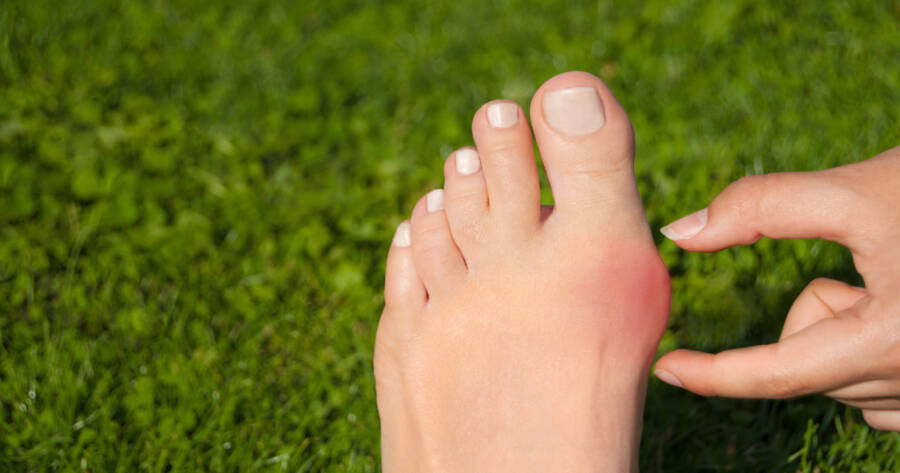Key Takeaways
- Due to a misaligned bone in your foot, the big toe veers toward the smaller toes, leading to a hardened, inflamed bunion.
- A variety of non-invasive treatments can relieve the symptoms, but they cannot correct the misaligned bone causing the bunion.
- In severe cases, a handful of surgical options can undo the deformity and relieve pain.
A bunion is a prominent, often painful bump that materializes at the base of the big toe on the inner aspect of the foot due to the misalignment of the bones. This misalignment results in the first metatarsal bone, which constitutes the big toe’s base, shifting towards the foot’s inner edge, thereby causing the big toe to lean towards the rest of the toes. Fortunately, if you start a search online today, you can learn about bunions as well as possible relief avenues.
Understanding Bunions: The Basics
Since a misaligned bone – scientifically known as hallux valgus – causes the big toe to veer toward the smaller toes, the persistent pressure and friction often lead to a hardened, inflamed bunion. People with flexible joints have a higher risk, but factors like genetics, footwear choices, and certain medical conditions can contribute.
Accompanying the physical change of a visible protrusion at the base of your big toe, symptoms also include:
- Persistent or intermittent pain, particularly when walking or wearing shoes.
- Swelling or redness around the affected joint.
- Limited movement of your big toe.
- The development of corns or calluses from toes overlapping may also occur, further compounding the discomfort.
Non-Invasive Bunion Pain Management Techniques
Before considering surgical options, non-invasive techniques can be implemented to manage bunion pain effectively. Designed to reduce pressure on the bunion and alleviate discomfort, these methods include:
- Appropriate footwear with a wide toe box can prevent additional stress on the bunion. Orthotic devices like padded shoe inserts may help distribute pressure evenly during movement to lessen pain.
- Physical therapy, including exercises and massage, can enhance joint mobility and decrease pain.
- Icing the area may offer temporary relief from inflammation and discomfort.
- Over-the-counter nonsteroidal anti-inflammatory drugs (NSAIDs), such as ibuprofen, can help manage pain and inflammation.
- Moleskin or gel-filled pads can also shield a bunion from friction, adding an extra layer of protection.
- In some cases, bunion splints can help realign the toes to their natural position.
Keep in mind that these methods only treat the symptoms, not the root cause of bunions.
Surgical Options: When is the Right Time?
While non-invasive treatments can offer symptomatic relief, they do not correct the misaligned bone causing the bunion. If the pain becomes severe or interferes with daily activities, it may be time to consider surgical options. Surgery, known as bunionectomy, aims to realign the bone, correct the deformity, and relieve pain.
It’s crucial to discuss your symptoms, activity level, and expectations with your doctor before opting for surgery. Surgery is usually the last resort when conservative methods fail to provide adequate relief. Remember that while surgery can potentially eliminate the bunion, it doesn’t guarantee a complete absence of pain or prevent recurrence.
Types of Bunion Surgery
There are various types of bunion surgeries, each designed to address specific issues related to the condition. Surgical options include:
- Osteotomy involves cutting and realigning the bones of your big toe.
- Exostectomy, on the other hand, removes the bulging bony growth but does not address bone misalignment.
- Arthrodesis replaces the arthritic joint with screws or metal plates to correct alignment.
- Resection arthroplasty involves removing damaged portions of the joint for older patients or severe cases.
The appropriate surgery depends on the bunion’s severity, the patient’s age, activity level, and overall health. Sometimes, surgeons may perform a combination of procedures to correct severe bunions.
Post-surgical recurrence of bunions is possible, especially if the underlying causes, like inappropriate footwear or bio-mechanical issues, are not addressed. Therefore, it is not just about selecting the right surgical procedure but also considering lifestyle modifications post-surgery.
The Recovery Phase
Recovery after bunion surgery varies based on the type of procedure and individual patient factors. Immediately after surgery, you may need to use crutches or a walking boot and avoid weight-bearing activities. Physical therapy can aid in regaining strength and flexibility in the toe.
The healing process can take several weeks to months, and swelling might persist for several months post-surgery. Following your surgeon’s guidelines for postoperative care can ensure the most effective recovery. Long-term success depends on factors like adhering to post-operative instructions and choosing appropriate footwear.
The emotional aspect of recovery is as vital as the physical recovery itself. A positive attitude can significantly impact your recovery time and satisfaction with the surgery results. During this phase, maintaining a balanced diet can aid in proper healing. It’s essential to remember that patience is key in this phase – rushing the recovery could potentially lead to complications.
Relief is Within Reach
Bunions can be a substantial source of discomfort and inconvenience, impacting your quality of life. Understanding the range of non-invasive methods and surgical options can empower you to make the best decision regarding your treatment.
Whether you are in the early stages of bunion discomfort or considering surgery, there is a path towards relief. Exploring available treatment options online can guide you toward recovery, as well as consulting with healthcare professionals who understand your needs and concerns. Embrace the journey with hope, because on the other side of this is the comfort and relief you deserve.
 Shutterstock: vasara
Shutterstock: vasara


